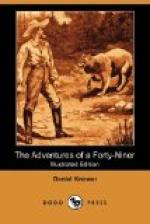Three persons started the first bank in San Francisco, called the Miners’ Bank, on the northwestern corner of the plaza. Mr. Haight, who was from Rochester, N.Y., and the sutler of Colonel Stevenson’s regiment, was one of them. It was said that at first they bought gold as low as $8 per ounce, when it was worth more than $18 at the mint East. The owners of the bank made $100,000 each in three or four years.
Before the discovery of gold the then small places on the Pacific Coast obtained their supplies from small trading vessels that sailed along the coast and stopped at their towns occasionally. After the discovery of gold, at first goods went up four or five times their previous value, and when one of these vessels was seen entering the port, parties would put out in small boats to get aboard of them before they came to anchor (they on board knowing nothing about the discovery of the gold), would bargain with them for some of their goods, and finally offer them so much for all their cargo. It being beyond their expectations the offer was generally accepted, and thus some big speculations were made.
A lieutenant of Stevenson’s regiment, who had been down in Monterey and had not heard of the gold discovery, on his first day in San Francisco, informed me that he did not know what to make of things. Most of his old acquaintances wanted to know if he did not want to borrow some money; they had some that he could have as well as not.
The steamers came in once a month with letters and papers. Then long lines were formed to the post-office. Sometimes it took half a day to get there. The New York papers at first sold for $1 each. Then they got down to fifty cents. I sold the New York Herald, that was more than a month old, that contained the latest news there from the States in the interior, for $5, and the man coaxed it out of me at that, for I wanted to give it to a party of friends I was going to see in the mining districts. I knew it would be a great treat to them. It is almost impossible to recall all the exact scenes of those days, so as to have them fully realized by the reader.
The city of San Francisco was extending more rapidly in what they called the Happy Valley district, which was toward the Mission of Dolores, established by the Jesuits. I visited it when the building was intact. I recollect a painting of an Indian warrior, with his bows and arrows, the implements of war, represented as a saint ascending to heaven—I suppose to create favorable impression on Indians and make converts of them.
My friend was going on with his brewery, and borrowing money and getting me deeper on his paper. He heard that I had $2,500 deposited with McCondery & Co., and pleaded with me to let him have it as it would carry him through. I had lost all confidence in him, and felt it would be like throwing it in the sea. I informed him that I had shipped it the day before, which I had not, but went right down and gave an order for its shipment, for fear he might over-persuade me to let him have it, and I thus saved it. When most completed, a barrel of alcohol that was in the building bursted, and it ran down to the furnace and set it on fire, and burnt it up. That was the fate of the first brewery started in California. Since then there have been millions made in that business there.




